The flag
The Australian Capital Territory flag was adopted by the Territory’s Legislative Assembly on 25 March 1993, after a public selection process.
The Australian Capital Territory flag is blue and gold, with the 5 stars of the Southern Cross on the left. On the right is the Coat of Arms of the City of Canberra. The blue and white swan symbolise First Nations Australians and European Australians. The castle alludes to Australia’s capital city, Canberra, and the Royal Crown (the Crown of St Edward) represents the role of the Sovereign in government. The sword of justice, the parliamentary mace and the white rose of York are depicted on the shield.
From 1927 until this new design became the official flag of the Australian Capital Territory, the city of Canberra’s flag had been used as a de facto flag. This flag features the full Coat of Arms of Canberra, including the swans as supporters.
The colour references are:
- Yellow: PANTONE® 123, and
- Blue: PANTONE® 293.
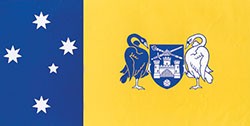
The Coat of Arms
The Coat of Arms were granted by Royal Warrant on 8 October 1928 to the Federal Capital Commissioners and their successors. The City of Canberra was granted its Coat of Arms on 7 November 1928. The Coat of Arms is protected against unauthorised use by the City of Canberra Arms Act 1932.
The mace of the Australian Parliament, the sword of justice and the white rose are shown on the shield of Canberra’s Coat of Arms, above and below the three‑towered “capital” castle. The white rose commemorates the contribution by the Duke of York (later to become King George VI) in opening the Commonwealth Parliament in Canberra on 9 May 1927.
On a wreath above the shield, is a crowned portcullis (gate) representing Canberra’s links with Westminster, the British seat of government. A gum tree is seen behind the portcullis and represents the growth of the garden city. The original Latin motto, “Pro Rege Lege et Grege” has been altered to “For the Queen, the Law, and the People”. The supporters are a pair of swans, one black and the other white, symbolising First Nations Australians and European Australians.
There is no Territory badge.
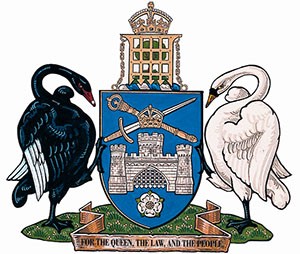
The floral emblem
The royal bluebell
The royal bluebell (Wahlenbergia gloriosa) was announced as the floral emblem for the Australian Capital Territory on 26 May 1982 by the Federal Minister for the Australian Capital Territory. Following the grant of self‑government for the Territory, it was formally endorsed by the Legislative Assembly as the official floral emblem for the Australian Capital Territory on 27 February 1997.
While the royal bluebell occurs only on the tops of the mountain ranges around Canberra, other native bluebells can be seen waving gently on thin stems, pushing up through the lawns, parks, pastures and roadside strips around Canberra.
The royal bluebell is native to the alpine and sub-alpine woodlands of the Australian Capital Territory, south eastern New South Wales and Victoria. It is protected in the wild and should not be picked or collected.
There are no legislative requirements surrounding use of the floral emblem.
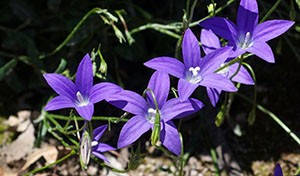
The animal emblem
Southern brush-tailed rock-wallaby
The southern brush-tailed rock-wallaby (Petrogale penicillata) was adopted as the Australian Capital Territory’s mammal emblem in November 2018.
The southern brush-tailed rock-wallaby is endangered and was last seen in the wild in the capital in 1959. In 1996, Tidbinbilla Nature Reserve started a conservation program from a captive population of 3 animals and since then they have successfully bred over 60 animals. The southern brush-tailed rock-wallaby also has a significant cultural importance to the First Nations Australians local Ngunnawal people.
There are no legislative requirements surrounding use of the mammal emblem.
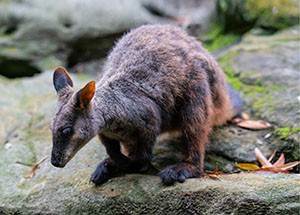
The bird emblem
Gang-gang cockatoo
The gang-gang cockatoo (Callocephalon fimbriatum) was endorsed by the Legislative Assembly as the official faunal emblem for the Australian Capital Territory on 27 February 1997.
Gang-gang cockatoos are showy dark grey birds with feathers edged with lighter grey or white. The males have strikingly coloured red heads capped with tousled longer feathers.
Each summer, gang-gang cockatoos flock to the mountain forests around Australia’s capital to breed in tree hollows and feed on eucalypt and acacia seeds, as well as the seeds of native pines.
During winter, small flocks make their homes around Canberra gardens to feed on pine cones, firethorn and hawthorn berries. They are creatures of habit, returning to the same tree or bush each day until the food supply is exhausted. Often they become so engrossed in their feeding that you can get close enough to admire their striking plumage.
Canberra residents know when gang-gang cockatoos are around - they have a raucous call like a squeaking gate and they fly in a characteristic undulating pattern. Canberra is the only city in Australia in which these cockatoos live.
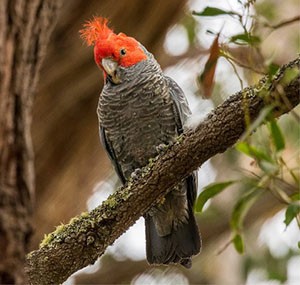
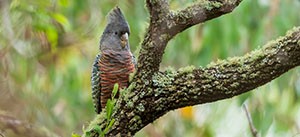
There are no legislative requirements surrounding use of the faunal emblem.
For further information on the symbols of the Australian Capital Territory, and for permission to reproduce the state Coat of Arms, please contact:
Communications and Engagement Division
Chief Minister, Treasury and
Economic Development Directorate
GPO Box 158
Canberra ACT 2601
Phone: 02 6205 3031
Email: govtsupport@act.gov.au
